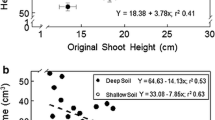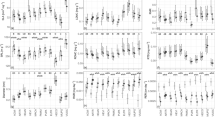Abstract.
Single and multiple linear regression techniques were used to explain the capacity of initial seedling root volume (Rv) and first-order lateral roots (FOLR) relative to shoot height, diameter, and fresh mass to serve as important indicators of stock quality and predictors of first- and second-year height and diameter on an afforestation site in southern Indiana, USA. This was accomplished for northern red oak (Quercus rubra L.), white oak (Quercus alba L.), and black cherry (Prunus serotina Ehrh) seedlings graded into four Rv categories at establishment. Field survival was high (85–97%) for all species. Initial diameter, height, fresh mass, and Rv provided similar predictive ability of second-year field response for absolute height (R2 = 0.59–0.77) and diameter (R2 = 0.50–0.73) for both oak species. Initial seedling Rv was a better predictor of field response than FOLR for both oak species, though not for cherry. Multiple-variable models accounted for a greater proportion of the total variation in seedling field height and diameter than did single-variable equations. The high R2 (up to 0.95) of regression models suggests field performance of these species can be reliably predicted and confirms the importance of initial seedling morphology in dictating early plantation performance.
Similar content being viewed by others
References
Bardon R.E. and Countryman D.W. 1993. Survival and growth for the first-growing season of northern red oak (Quercus rubra L.) seedlings underplanted in mixed upland hardwood stands in south central Iowa. In: Gillespie A.R., Parker G.R., Pope P.E. and Rink G.Proc. 9th Central Harwood Forest Conference. USDA For. Serv., North Central Forest Exp. Sta., St. Paul, MN. Gen. Tech. Rep. NC-161, pp. 195–209.
T.J. Blake R.F. Sutton (1987) ArticleTitleVariation in water relations of black spruce stock types planted in Ontario Tree Physiol. 3 331–344 Occurrence Handle14975917
A.N. Burdett L.J. Herring C.F. Thompson (1984) ArticleTitleEarly growth of planted spruce Can. J. For. Res. 14 644–651
A.N. Burdett (1979) ArticleTitleA nondestructive method for measuring the volume of intact parts Can. J. For. Res. 9 120–122
A.N. Burdett (1990) ArticleTitlePhysiological processes in plantation establishment and development of specification for forest planting stock Can. J. For. Res. 20 415–427
W.C. Carlson (1986) ArticleTitleRoot system considerations in the quality of loblolly pine seedlings South. J.␣Appl. For. 10 87–92
C.G.R. Chavasse (1977) ArticleTitleThe significance of planting height as an indicator of subsequent seedling growth New Zeal. J. For. 22 283–296
S.L. Clark S.E. Schlarbaum P.P. Kormanik (2000) ArticleTitleVisual grading and quality of 1-0 northern red oak seedlings South. J. Appl. For. 24 93–97
B.D. Cleary R.D. Greaves P.W. Owston (1978) Seedlings B.D. Cleary R.D. Greaves R.K. Hermann (Eds) Regenerating Oregon’s Forests Oregon State Univ. Extension Service Corvallis, OR 63–98
T.R. Crow (1988) ArticleTitleReproductive mode and mechanisms for self replacement of northern red oak (Quercus rubra) – a review For. Sci. 34 19–40
M.C. Demchik W.E. Sharpe (2000) ArticleTitleThe effect of soil nutrition, soil acidity and drought on northern red oak (Quercus rubra L.) growth and nutrition on Pennsylvania sites with high and low red oak mortality For. Ecol. Manage. 136 199–207 Occurrence Handle10.1016/S0378-1127(99)00307-2
D.C. Dey W.C. Parker (1997) ArticleTitleMorphological indicators of stock quality and field performance of red oak (Quercus rubra L.) seedlings underplanted in a central Ontario shelterwood New Forests 14 145–156 Occurrence Handle10.1023/A:1006577201244
R.K. Dixon H.E. Garrett G.S. Cox S.G. Pallardy (1984) Mycorrhizae and reforestation success in the oak-hickory region M.L. Duryea W. Brown (Eds) Seedling Physiology and Reforestation Success Nijhoff/Dr. W. Junk Pub. Boston, MA 301–309
M.L. Duryea (1985) Evaluating seedling quality: importance to reforestation M.L. Duryea (Eds) Evaluating Seedling Quality: Principles, Procedures, and Predictive Abilities of Major Tests Forest Research Laboratory, Oregon State University Corvallis, OR 1–6
A.D.M. Glass (2002) Nutrient absorption by plant roots: regulation of uptake to match plant demand Y. Waisel A. Eshel U. Kafkafi (Eds) Plant Roots: The Hidden Half, 3rd ed. Marcel Dekker Inc. New York 571–586
D.L. Haase R. Rose (1993) ArticleTitleSoil moisture stress induces transplant shock in stored and unstored 2 + 0 Douglas–fir seedlings of varying root volumes For. Sci. 39 275–294
R.R. Hicks SuffixJr. (1998) Ecology and Management of Central Hardwood Forests John Wiley and Sons Inc. New York 412
Jacobs D.F. and Seifert J.R. 2004. Re-evaluating the significance of the first-order lateral root grading criterion for hardwood seedlings. In: Proc,14th Central Hardwood Forest Conference. USDA For. Serv., North Central Forest Exp. Sta., St. Paul, MN. Gen. Tech. Rep. NE-316, pp.␣382–388.
D.F. Jacobs R. Rose D.L. Haase P.O. Alzugaray (2004a) ArticleTitleFertilization at planting impairs root system development and drought avoidance of Douglas–fir (Pseudotsuga menziesii) seedlings Ann. For. Sci. 61 643–651 Occurrence Handle10.1051/forest:2004065
D.F. Jacobs A.L. Ross-Davis A.S. Davis (2004b) ArticleTitleEstablishment success of conservation tree plantations in relation to silvicultural practices in IndianaUSA New Forests 28 23–36 Occurrence Handle10.1023/B:NEFO.0000031329.70631.d0
P.S. Johnson (1984) ArticleTitleResponse of planted northern red oak to three overstory treatments Can. J. For. Res. 14 536–542
Johnson P.S. 1992. Underplanting northern red oak in Missouri without herbicides. USDA For. Serv., North Central Forest Exp. Sta., St. Paul, MN. Gen Tech. Rep. NC-152.
P.S. Johnson S.L. Novinger W.G. Mares (1984) ArticleTitleRootshootand leaf area growth potentials of northern red oak planting stock For. Sci 30 1017–1026
P.S. Johnson S.R. Shifley R. Rogers (2002) The Ecology and Silviculture of Oaks CAB International New York 503
Kaczmarek D.J. and Pope P.E. 1993a. Covariate analysis of northern red oak seedling growth. In: Brissette J.C.eds., Proc. 7th Biennial Southern Silvicultural Research Conference. USDA For. Serv., Southern Forest Expt. Sta., AshevilleNC. Gen. Tech. Rep. SO-93, pp. 351–356.
Kaczmarek D.J. and Pope P.E. 1993b. Seedling morphology related to growth and survival of northern red oak. In: Thompson J.R.R., Schultz R.C. and Van Sambeek J.W. eds., 5th Workshop on Seedling Physiology and Growth Problems in Oak Plantings. USDA For. Serv., North Central Forest Expt. Sta., St. Paul, MN. Gen. Tec. Rep. NC-159, pp. 11.
Kormanik P.P., Ruehle J.R. and Muse H.D. 1988. Frequency distribution of seedlings by first-order lateral roots: a phenotypic or genotypic expression. In: Proc. 31st Northeastern Forest Tree Improvement Conference University Park, PAPenn. St. Univ., University Park, PApp. 181–187.
Kormanik P.P., Sung S.S., Kormanik T.L. and Zarnoch S.J. 1995. Oak regeneration why big is better. In: Landis T.D. and Cregg B. (Tech. Coords.), National Proceedings, Forest and Conservation Nursery Associations. USDA For. Serv., Pacific NW Res. Sta., Fort Collins, CO., Gen. Tech. Rep. PNW-GTR-365, pp. 117–123.
J.P. Kramer (1986) ArticleTitleThe role of physiology in forestry Tree Physiol. 2 1–16 Occurrence Handle14975837
P.C. Kramer H.C. Bullock (1966) ArticleTitleSeasonal variations in the proportions of suberized and unsuberized roots of trees in relation to the absorption of water Am. J. Bot. 53 200–204
H.A. Margolis D.G. Brand (1990) ArticleTitleAn ecophysiological basis for understanding plantation establishment Can. J. For. Res. 20 375–390
A. Mattsson (1997) ArticleTitlePredicting field performance using seedling quality assessment New Forests 13 227–252 Occurrence Handle10.1023/A:1006590409595
J.D. McMillin M.R. Wagner (1995) ArticleTitleEffects of water stress on biomass partitioning of ponderosa pine seedlings during primary root growth and shoot growth periods For. Sci. 41 594–610
E.K.S. Nambiar R. Sands (1993) ArticleTitleCompetition for water and nutrients in forests Can. J. For. Res. 23 1955–1968
J. Neter M.N. Kutner C.J. Nachtshein W. Wasserman (1996) Applied Linear Regression Models Irwin Chicago 714
Oak S.W., Huber C.M. and Sheffield R.M. 1991. Incidence and impact of oak decline in West Virginia1986. USDA For. Serv., Southeastern Forest Exp. Sta., AshevilleNC. Res. Bull. SE-123.
F. Ponder SuffixJr. (2000) ArticleTitleSurvival and growth of planted hardwoods in harvested openings with first-order lateral root differences, root dipping, and tree shelters North. J. Appl. For. 17 45–50
Pope P.E. 1993. A historical perspective of planting and seeding oak. Progress, problems and status. In: Loftis D.L. and McGee C.E. eds.,Proc. Oak Regeneration: Serious problems, practical recommendations. USDA For. Serv., Southeastern Forest Exp. Sta., AshevilleNC. Gen. Tech. Rep. SE-84, pp. 224–240.
P. Puttonen (1996) ArticleTitleLooking for the “silver bullet”-can one test do it all? New Forests 13 9–27 Occurrence Handle10.1023/A:1006557502326
G.D. Racey (1985) ArticleTitleA comparison of plating stock characterization with root area index, volumeand dry weight For. Chron. 61 64–70
G.A. Ritchie J.R. Dunlap (1980) ArticleTitleRoot growth potential – its development and expression in forest tree seedlings New Zeal. J. For. Sci. 10 218–248
R. Rose M. Atkinson J. Gleason T. Sabin (1991a) ArticleTitleRoot volume as a grading criterion to improve field performance of Douglas–fir seedlings New Forests 5 195–209 Occurrence Handle10.1007/BF00028111
Rose R., Carlson W.C., Morgan P. 1990. The target seedling concept. In Rose R., Cambell S.J., Landis T.D. eds.,Proc. Combined meeting of the Western Forest Nursery Associations. USDA For. Serv., Rocky Mtn. Forest and Range Expt. Sta., Fort Collins, CO. Gen. Tech. Rep. RM-200. pp. 1–8
R. Rose J. Gleason M. Atkinson T. Sabin (1991b) ArticleTitleGrading ponderosa pine seedlings for outplanting according to their root volume West. J. Appl. For. 6 11–15
R. Rose D.L. Haase F. Kroiher T. Sabin (1997) ArticleTitleRoot volume and growth of ponderosa pine and Douglas fir seedlings: a summary of eight growing seasons West. J. Appl. For. 12 69–73
K.F. Salifu (2002) ArticleTitleBulk densities of Ghanaian forest soils in relation to other physico-chemical soil parameters J. Trop. For. Sci. 14 49–60
K.F. Salifu V.R. Timmer (2001) ArticleTitleNutrient retranslocation response of Picea mariana seedlings to nitrogen supply Soil Sci. Soc. Am. J. 65 905–913
K.F. Salifu V.R. Timmer (2003) ArticleTitleNitrogen retranslocation response of young Picea mariana to nitrogen-15 supply Soil Sci. Soc. Am. J. 67 309–317
R. Sands (1984) ArticleTitleTransplanting stress in radiata pine Aust. For. Res. 14 67–72
InstitutionalAuthorNameSAS Institute Inc. (2001) SAS Version 8.2 SAS Inc. Cary, NC
R.C. Schultz J.R. Thompson (1990) ArticleTitleNursery cultural practices that improve hardwood seedling root morphology Tree Plantersȁ9 Notes 41 21–32
R.C. Schultz J.R. Thompson (1997) ArticleTitleEffect of density control and undercutting on root morphology of 1 + 0 bareroot hardwood seedlings: five-year field performance of root-graded stock in central USA New Forests 13 297–310 Occurrence Handle10.1023/A:1006594510503
InstitutionalAuthorNameSPSS Inc. (2001) SPSS Version 11.0 SPSS Inc. ChicagoIL
E.E. Stange K.L. Shea (1998) ArticleTitleEffects of dear browsing, fabric mats, and tree shelters on Quercus rubra seedlings Restoration Ecol. 6 29–34 Occurrence Handle10.1046/j.1526-100X.1998.06114.x
D.K. Struve (1990) ArticleTitleRoot regeneration in transplanted deciduous nursery stock HortScience 25 266–270
D.K. Struve R.J. Joly (1992) ArticleTitleTransplanted red oak seedlings mediate transplant shock by reducing leaf surface area and altering carbon allocation Can. J. For. Res. 22 1441–1448
R.M. Teclaw J.G. Isebrands (1993) ArticleTitleAn artificial regeneration systems for establishing northern red oak on dry-mesic sites in the Lake States, USA Ann. For. Sci. 50 543–552
B.E. Thompson (1985) Seedling morphological evaluation: what you can tell by looking M.L. Duryea (Eds) Evaluating Seedling Quality: Principles, Procedures, and Predictive Ability of Major Tests Oregon State Univ. Corvallis, OR 59–71
J.R. Thompson (1991) Influence of root system morphology and site characteristics on development of transplanted northern red oak (Quercus rubra L.) seedlings Iowa State Univ. Ames
J.R. Thompson R.C. Schultz (1995) ArticleTitleRoot system morphology of Quercus rubra L. planting stock and 3-year field performance in Iowa New Forests 9 225–236 Occurrence Handle10.1007/BF00035489
C.E. Tripler C.D. Canham R.S. Inouye (2002) ArticleTitleSoil nitrogen availability, plant luxury consumption, and herbivory by white-tailed deer Oecologia 133 517–524 Occurrence Handle10.1007/s00442-002-1046-x
J.S. Ward M.P.N. Gent G.R. Stephens (2000) ArticleTitleEffects of planting stock quality and browse protection-type on height growth of northern red oak and eastern white pine For. Ecol. Manage. 127 205–216 Occurrence Handle10.1016/S0378-1127(99)00132-2
Author information
Authors and Affiliations
Corresponding author
Rights and permissions
About this article
Cite this article
Jacobs, D., Salifu, K. & Seifert, J. Relative contribution of initial root and shoot morphology in predicting field performance of hardwood seedlings. New Forest 30, 235–251 (2005). https://doi.org/10.1007/s11056-005-5419-y
Received:
Accepted:
Issue Date:
DOI: https://doi.org/10.1007/s11056-005-5419-y




